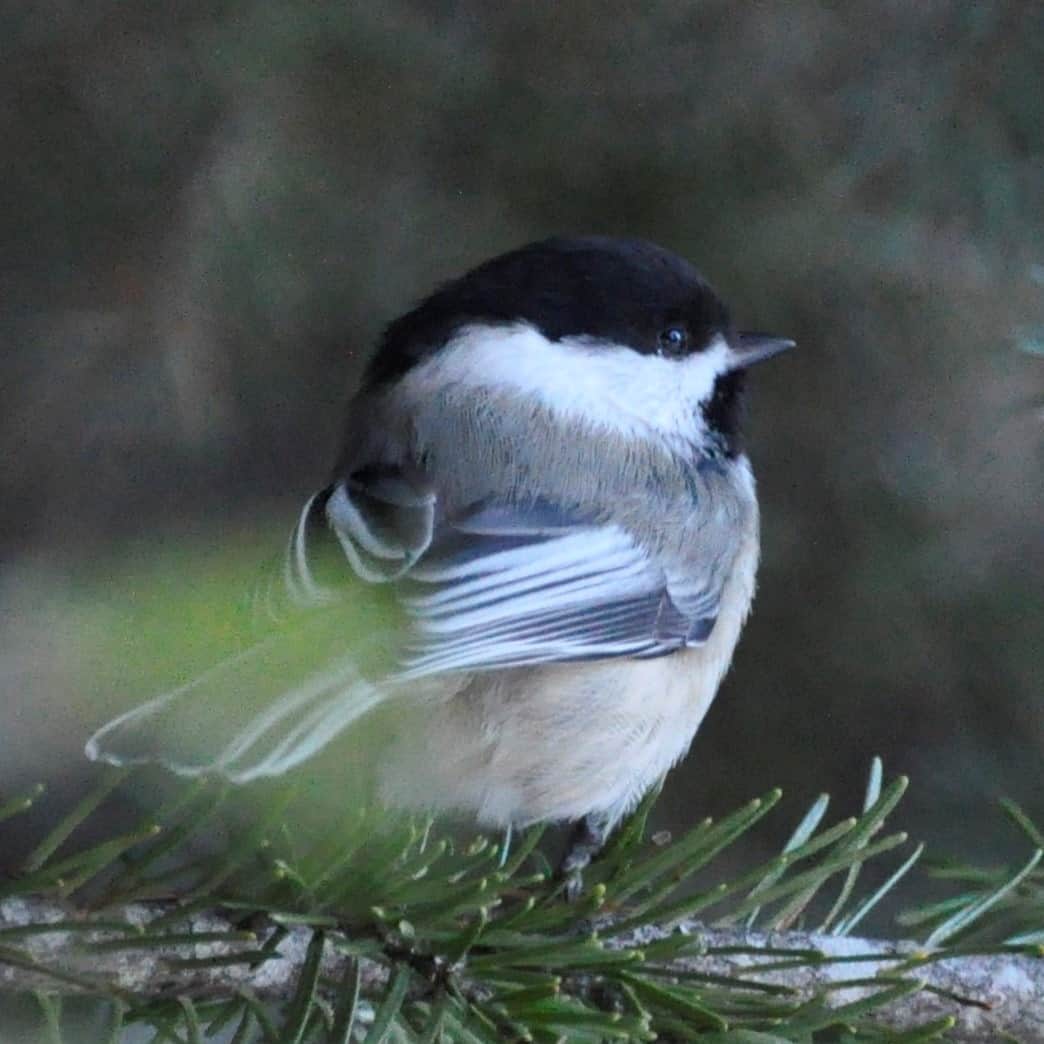Attract black-capped chickadees with 9 insider secret tips. After all, who wouldn’t want these sweet little birds in their yard? The best part is this cute little chickadee is a regular visitor at the feeder and easy to attract when your yard is irresistible.
I’ve had adorable black-capped chickadees visiting my feeder year-round for over 25 years so I know first-hand the ways to keep them coming.
9 Ways to Attract Black-Capped Chickadees to Your Yard:
- Make it Wiggly with Mealworms
- Go Organic
- Provide Appealing Feeder Food
- Have Water Available
- Plant Native
- Avoid Clearing Dead, Dying Trees
- Install A Black-Capped Chickadee Approved Nesting Box
- Offer Nesting Material
- Keep Kitty Inside
Before I get into the detail I’d first like to share where they live, what they look like, their habitat, sounds, diet, mating, and nesting habits.
If you’re in a hurry feel free to skip ahead to the details.
Where Black-Capped Chickadees Live
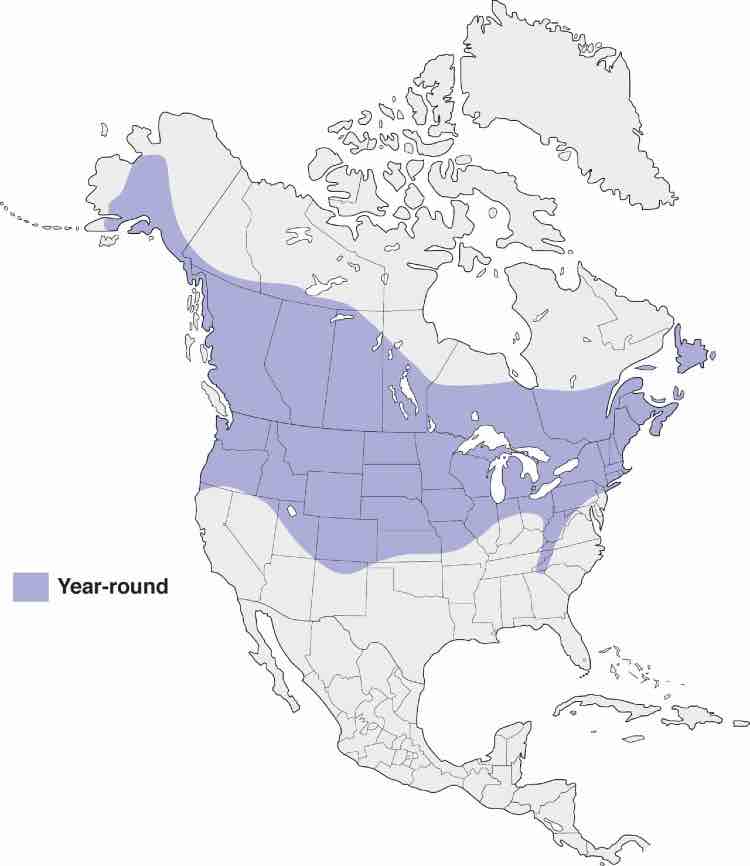
Black-capped chickadees are year-round birds in the northern half of the US and much of Canada.
Appearance
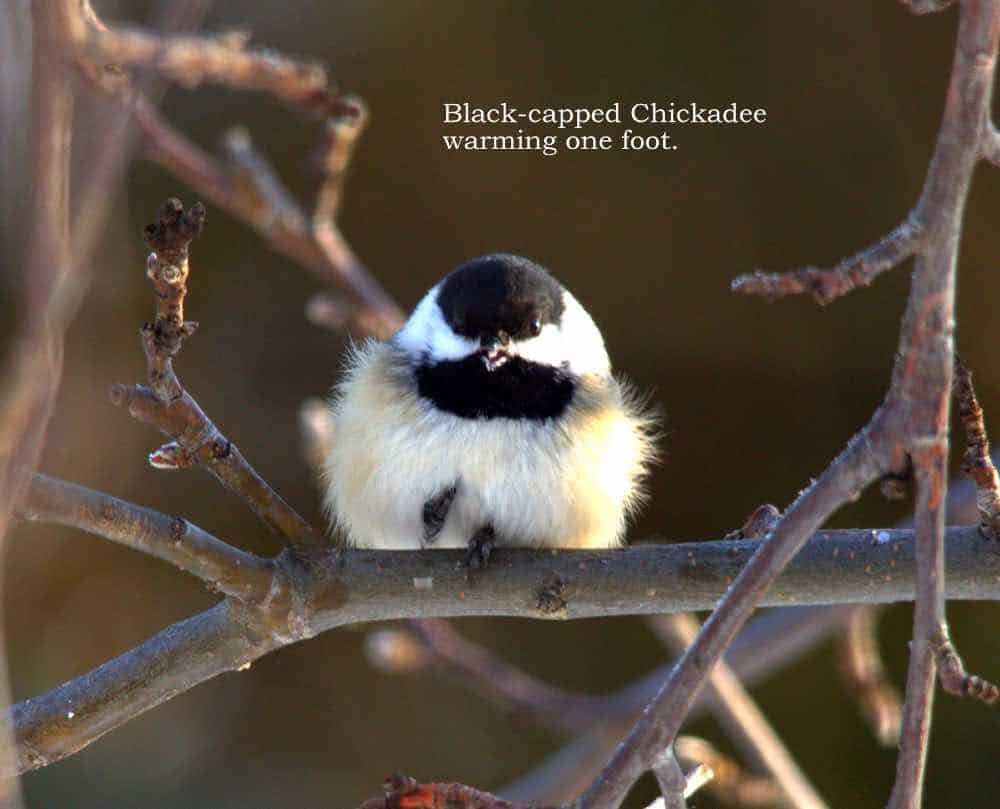
Black-capped chickadees are small birds about 5 1/4″ long.
Guess what color their cap is. Go ahead…guess. Yes! This bird has a black cap – as well as a black throat and cheek.
They have white breasts and bellies, their bodies and wings are a gray-olive color with edges of white and the wing/belly edge is a soft “buff” tan. During the summer, the buff area is more faded.
Did you know? Chickadees are often associated with happiness and optimism. When you see one, it might be a reminder to maintain a positive outlook and focus on the bright side of life. This can help you attract more positive experiences and opportunities.
Habitat
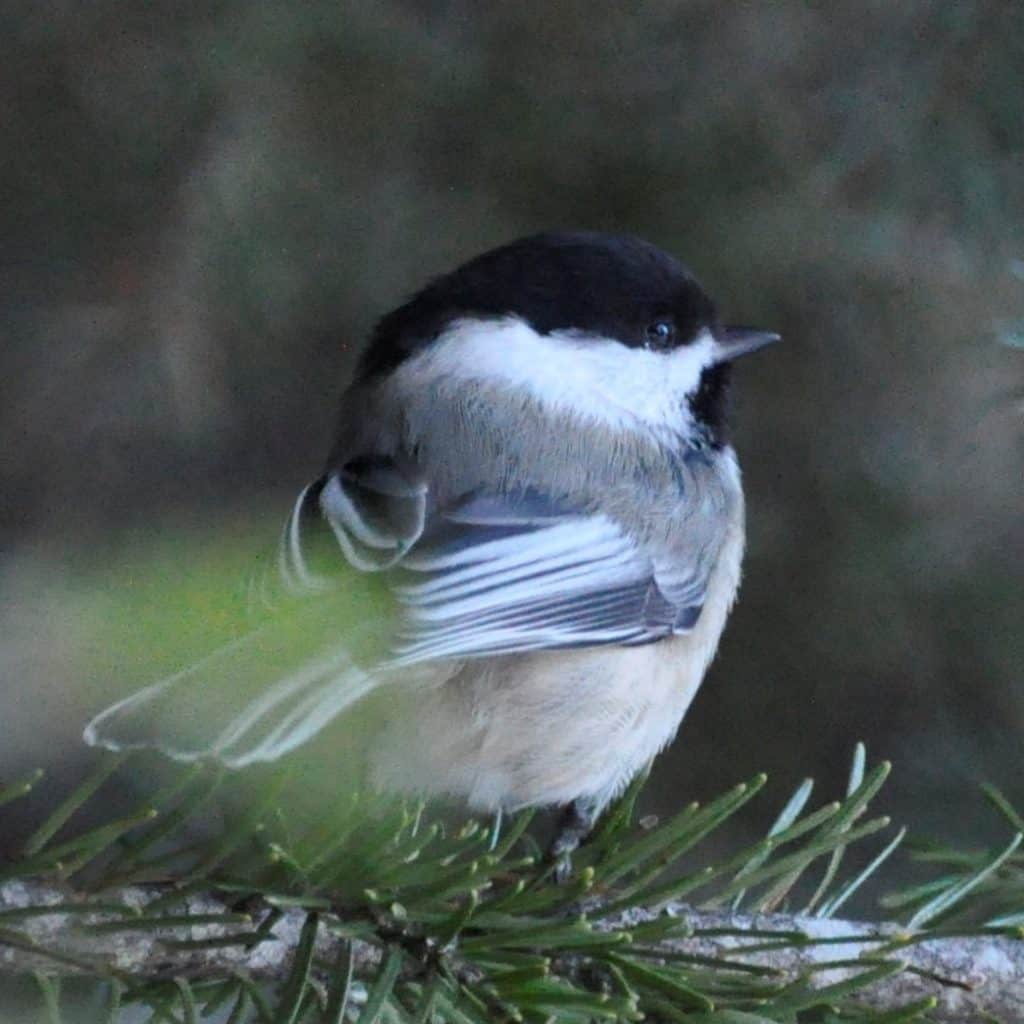
You’ll find this bird along the edges of forests and open wooded areas – including your backyard or even tree-lined parks in the city. They will also hang out in shrubs and willow thickets.
Trees are still important for this bird because they are cavity nesters. More on that in a bit.
Diet & Feeding Behavior
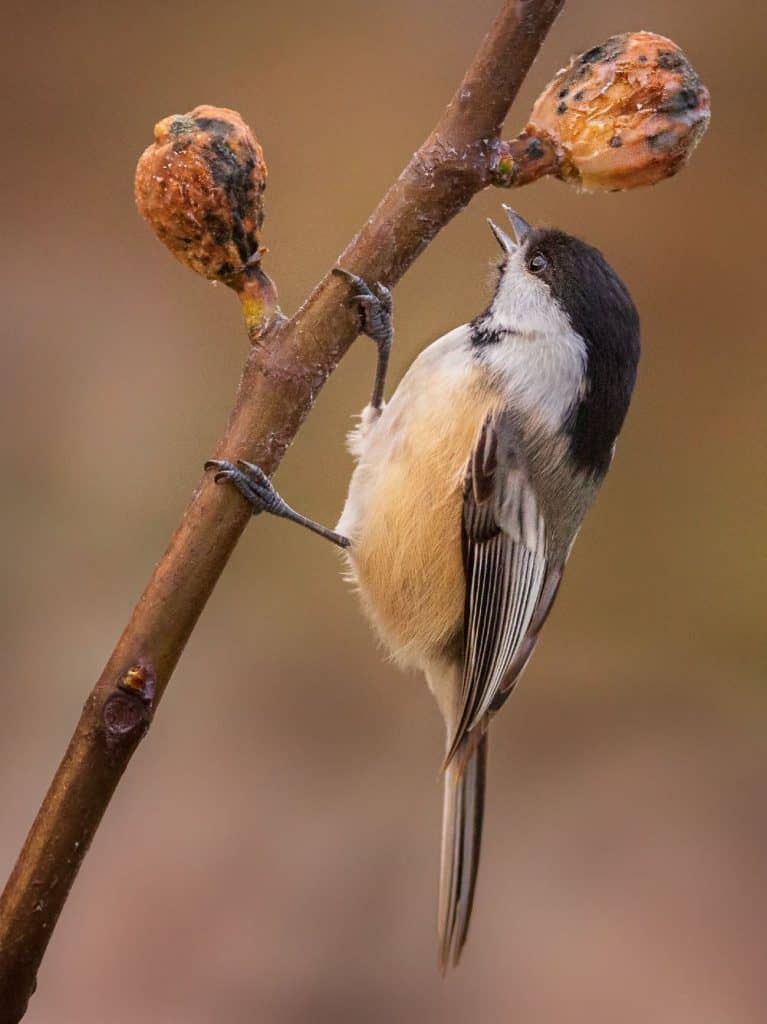
This little cutie dines on insects & spiders (including their eggs & pupae), seeds, and small fruits.
During breeding season 90% of their diet is mostly caterpillars.
During the winter, as insects and spiders become scarce, their diet is more reliant on seeds and berries from plants including pine trees, hemlock, birch, yew, and poison ivy.
Being very social birds, black-capped chickadees are very popular at the feeder. Many a backyard birder has enticed one to their hand offering just seeds.
Like many wild birds, they will cache large quantities of seeds in the crack of bark for later. Others will consume the seed right away – sometimes flying off to a nearby perch to eat.
Sounds
Nesting, Eggs, and Fledglings
These chickadees are cavity nesters. They look for existing cavities to nest in such as an old woodpecker hole high in a tree. Although these are ideal, they’ll often be further excavated to make the cavity larger.
They’ll also go for a man-made nesting box. Below is a black-capped chickadee exploring my bluebird house for a potential nesting site.
The nest site is typically lined with plant material including moss, weeds, and animal fur.
Pairs have 1 brood each season.
Female lays anywhere from 1-13 eggs. Eggs are white with burgundy colored spots and about .5″ wide x .6″ long. She will incubate them for 12-13 days.
After 16 days the young are ready to fledge.
Predators
Adult black-capped chickadees are at risk of being attacked by hawks, owls, and shrikes (the butcher bird).
The eggs and young are highly at risk from climbing mammals such as raccoons, squirrels, and snakes.
Nine Ways to Attract Black-Capped Chickadees They Can’t Resist
1. Make it Wiggly with Mealworms
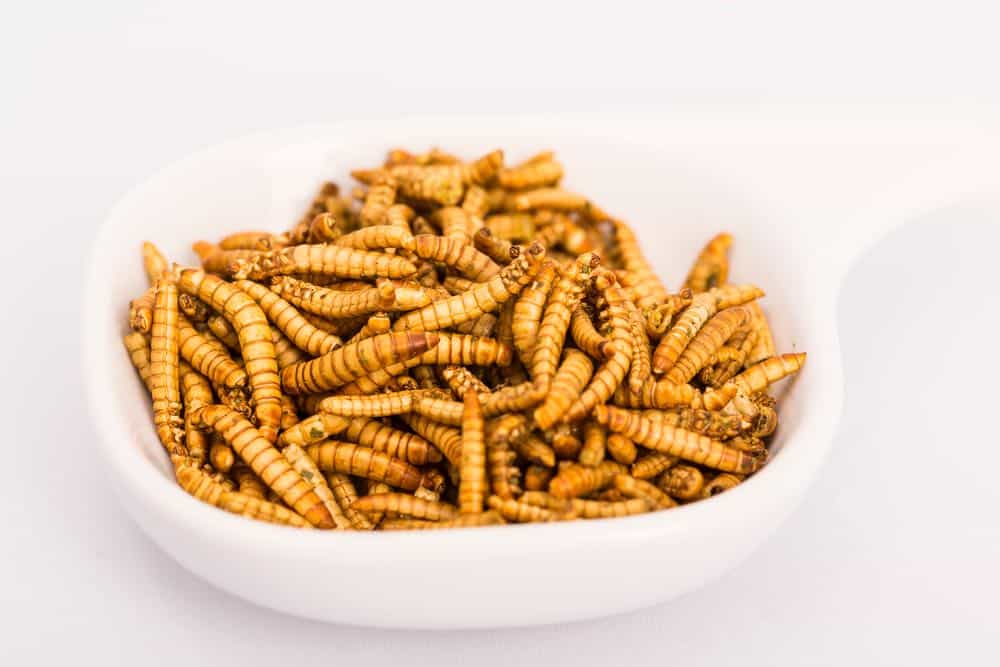
You can attract black-capped chickadees with mealworms. They’re actually the larvae of the mealworm beetle and since chickadees’ primary source of food is insects – this food is ideal and easy to offer.
Live mealworms are commonly available at your local nature store and dehydrated varieties are available online as well as at the local nature store.
Dehydrated mealworms last longer, require no maintenance, and are cheaper but sometimes take birds longer to realize they are actually food, delaying their visit to your yard.
Pro tip: Offer 1/2 dozen live, wiggly mealworms at first to catch the bird’s eye more easily. Then, slowly transition to a mix of live and dehydrated mealworms until you are offering exclusively dehydrated.
Mealworms can be placed in a dish for the birds – just make sure the dish has sides when offering live ones otherwise they’ll climb out and escape!
2. Go Organic
Avoid using chemicals in and around your yards such as grass fertilizer and pesticides. Black-capped chickadees, and other wild birds, consume insects as their primary source of food and if you kill them off, there won’t be any to eat.
Equally horrible would be death by poisoning in the case of a wild bird eating a toxic insect!
3. Provide Appealing Feeder Food
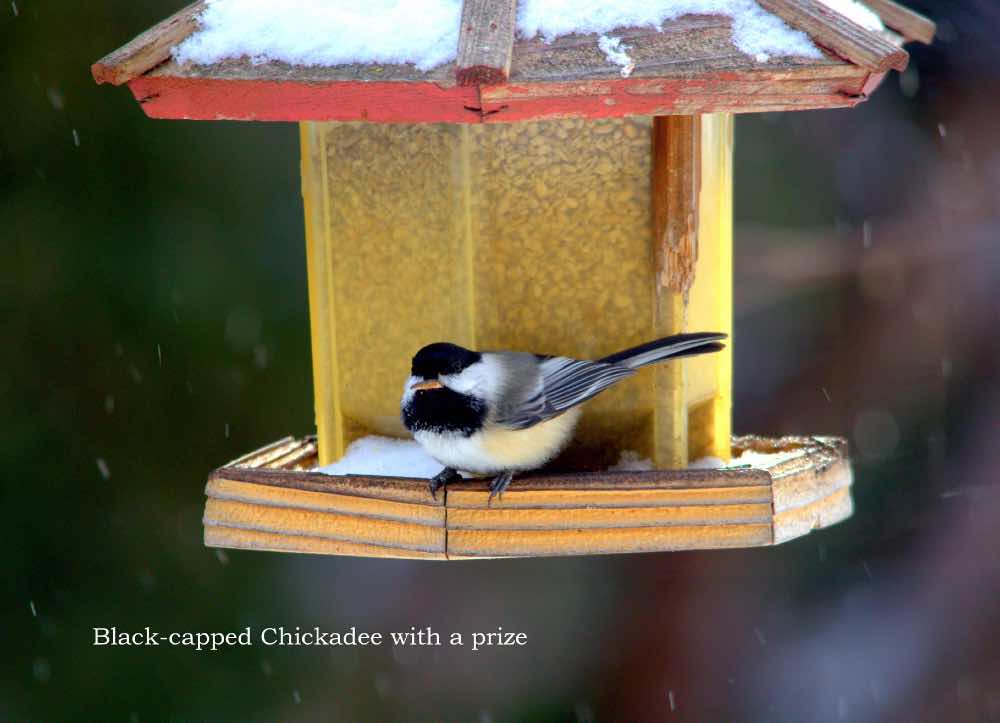
You can invite black-capped chickadees to your yard by offering their favorite foods. Of all the bird food people offer at the feeder, these are the ones black-capped chickadees seem to love the most:
- Black-oil sunflower & safflower seeds (They peck a hole in the shell to get at the tiny seed bits inside).
- Suet
- Peanut butter spread
- Hulled Peanuts
4. Have Water Available
All birds need water to drink and bathe in. You can attract black-capped chickadees with water. If a natural source of water is not available nearby consider installing a pond – even a small patio pond will attract all wild birds.
A birdbath is another viable option. Birds are drawn to moving water so adding a fountain to the birdbath could increase your chances of attracting one. Black-capped chickadees are small birds so make sure the birdbath does not exceed 1/2 in-depth or add layers of flat rocks as an alternative.
5. Plant Native
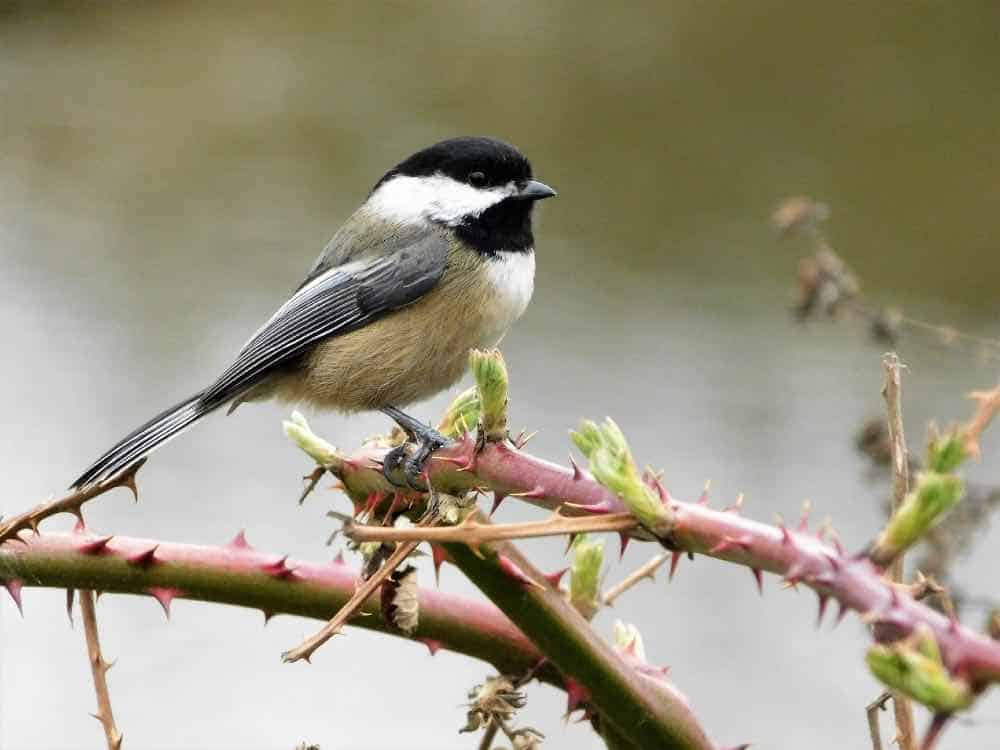
During the fall, winter, and early spring when insects are scarce, these cuties get their sustenance from tree and shrub berries.
Trees and shrubs also provide protection from predators such as hawks.
Native plants are particularly ideal because they don’t require special treatment to thrive. Non-native plants often require toxic fertilizers and pesticides which can kill birds.
Here are some native plants you can include in your yard that attract black-capped chickadees:
- Pines
- Hemlock
- Birch
- Yew
- American Holly
- Black Cherry
- Pin Cherry
- Red Mulberry
- Serviceberry
- Hackberry
They also like to eat poison ivy but I don’t recommend planting that in your yard.
6. Avoid Clearing Dead, Dying Trees
You can attract black-capped chickadees with dead trees. Standing trees with holes excavated and abandoned by woodpeckers are ideal for chickadees to nest in. If you’re serious about attracting them to your yard, resist the urge to knock down and haul away these trees.
7. Install A Black-Capped Chickadee Approved Nesting Box
These little darlings are cavity nesters meaning they build their nest inside a hole such as a drilled-out tree hole left by woodpeckers or a man-made nesting box. You can attract black-capped chickadees by offering a birdhouse.
Many other birds are also cavity nesters resulting in a very competitive hunt for nesting sites. Also, some of the other birds are big bullies which leaves chickadees at a disadvantage.
According to Nestwatch, black-capped chickadees are declining in population for parts of their range (mostly west and north). You can help them by providing a nest box.
It’s important to purchase or build a nest box with these chickadee-specific requirements.
- Should be made from cedar or redwood for longer wear;
- Should not be painted or stained to avoid toxicity – especially inside the box;
- The roof overhang should be close to the entry hole, so water can’t enter the box.
- Air holds at the top and drainage holes at the bottom.
- The entry hole should be round and 1 1/8″ in diameter to prevent large bully birds like European starlings from entering.
- Box size: 5 1/2″ x 5 1/2″ and 8″ deep.
- Easy access door to remove old nesting material but secure enough that animals cannot enter.
Bonus Tips
- Add wood shavings to the box chickadees seem to like this.
- Install the nest box 5-15′ off the ground on a post or pole and position it to the east toward the open habitat area and away from the elements.
- Attach guards to deter nest-raiding predators.
- To deter house sparrows, many have had success installing screws to the 4 corners of the roof and winding fishing lines from corner to corner and diagonally. No one truly knows why it works but many have reported success with this tip.
Did you know? It’s illegal to disturb the nest of a native bird. House sparrows and European starlings are non-native birds so the law doesn’t apply to them. In fact, some organizations encourage the removal and destruction of these birds.
8. Offer Nesting Material
You can attract black-capped chickadees by making nesting easier for them. By providing nesting materials they can spend less time seeking it out and more time building the nest.
Pet fur is ideal as well as short pieces of string remnants. Trying to put them in an empty suet cage and hanging for them to find.
Caution: Never provide human hair as birds can get tangled in it.
9. Keep Kitty Inside

A primary predator of birds everywhere is cats – domestic cats. This includes feral cats that can roam a neighborhood.
According to a study published in Nature Communications, each year almost 4 billion wild birds lose their lives to outdoor cats. Not only does this rock the ecology it makes your yard unappealing and dangerous for many forms of wildlife.
If it’s your cat, keep it inside. Don’t be fooled. Even the nicest and sweetest of kitties have the natural instinct to hunt birds. It’s not their fault.
If it’s a feral cat implement a non-toxic deterrent method such as scattered fresh orange or lemon peels in the area.
If you’re really gung ho, consider trapping the feral feline and taking it to a human society that offers free neutering/spaying. This may prevent the next person from having to deal with a feral cat at their feeder.
Next Steps
I think you’ll agree that black-capped chickadees are worth the effort to attract to your yard. Take and apply some of the tips I provided or if you’re really serious about attracting them to your yard – apply all of them! Good luck and happy birding!

